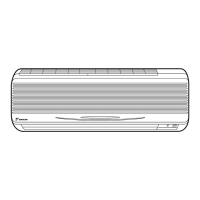What to do if the operation of my Daikin FTS50BVMB is interrupted due to lightning?
- EEduardo GoodmanSep 13, 2025
To protect your system, stop operation of your Daikin Air Conditioner and turn the breaker OFF.

What to do if the operation of my Daikin FTS50BVMB is interrupted due to lightning?
To protect your system, stop operation of your Daikin Air Conditioner and turn the breaker OFF.
| Brand | Daikin |
|---|---|
| Model | FTS50BVMB |
| Category | Air Conditioner |
| Language | English |
Critical warnings for property damage, personal injury, or loss of life if instructions are ignored.
Cautions for minor to moderate property damage or personal injury if instructions are not followed.
Precautions against fire, explosion, injury from gases, and fan rotation hazards.
Safety for earthing, wet hands, refrigerant leaks, repairs, and power supply issues.
Avoid injury by not standing on, placing objects on, or touching outdoor unit parts.
Ensure room ventilation and follow safe cleaning procedures for the unit.
Choose appropriate sites, avoiding oily or corrosive environments for proper installation.
Use dedicated circuits and consult professionals for relocation to ensure safety.
Identifies key indoor unit parts: filters, grilles, displays, and the ON/OFF switch.
Details the main control panel elements and their functions on the indoor unit.
Illustrates and names outdoor unit parts: air inlet, outlet, piping, and drain hose.
Describes specific indoor unit components like sensors and the signal receiver.
Identifies the transmitter, display, and primary buttons like ON/OFF and MODE.
Explains buttons for POWERFUL, TEMP, FAN, SWING, TIMER, and CLOCK functions.
Guides on inserting AAA batteries and provides recommendations for battery usage.
How to aim the transmitter, understand communication distance and precautions.
Instructions for fixing the remote controller holder securely to a wall or pillar.
Procedure to set the current time using CLOCK and TIMER buttons.
Advice on reducing consumption: moderate temps, using curtains, cleaning filters.
Recommended conditions for modes and notes on safety devices and condensation.
How to start the unit by selecting a mode and pressing ON/OFF.
How to stop the unit by pressing the ON/OFF button again.
Guides on changing temperature settings for different modes using TEMP buttons.
Adjusting air flow rate using the FAN button in different modes.
Specific notes on HEAT, DRY, AUTO, and air flow rate settings for optimal performance.
Adjusting horizontal flap using SWING button for desired airflow.
Manually adjusting vertical louvres using knobs on the unit.
Notes on swing ranges by mode and cautions against moving louvres forcibly.
Activating POWERFUL mode for maximum effect; duration and limitations.
Exiting POWERFUL mode by pressing the button again.
Mode-specific effects of POWERFUL mode on settings and capacity.
Setting the OFF TIMER for automatic shutdown, including clock check.
Cancelling the set OFF TIMER operation using the CANCEL button.
Timer memory, duration variations, and NIGHT SET MODE details.
Setting the ON TIMER for automatic startup, including clock check.
Cancelling the set ON TIMER operation using the CANCEL button.
Example of setting both ON and OFF timers for scheduled operation.
Re-setting timers after power interruptions or battery replacement.
Wiping indoor/outdoor units and remote controller with a dry cloth.
Steps to open, remove, clean, and reattach the front grille.
Warnings against touching metal parts, using unstable stools, hot water, or harsh chemicals.
Washing air filters with water or vacuuming; recommended cleaning every two weeks.
Cleaning the air purifying filter every 6 months and replacing it every 3 years.
Removing old filters, replacing with new ones, and proper disposal.
Checks for outdoor unit, air inlets/outlets, earth wire, and drain hose.
Steps for storage: fan operation, cleaning filters, battery removal.
Effects of dirty filters on performance/odor; how to order replacements.
Explains delayed starts, fan rotation after stop as normal operations.
Explains hot air delay, steam, mists, odors, and fan rotation during non-operation.
Checks for power, fuses, batteries, timers, and filters when unit is off.
Checks for filters, airflow, temperature settings, and door/window status.
Resolving stops/malfunctions: power cycling, checking interference.
Stop operation and call service for smells, hot cords, abnormal sounds.
Warns against self-repair due to shock/fire risks; recommends professional help.
Lists issues like breaker trips, faulty buttons, burning smells, water leaks needing service.
Automatic resumption after power failure and safety during lightning.
Disposal requirements and recommendation for periodic professional maintenance.
Enter diagnostic mode by holding the TIMER CANCEL button for 5 seconds.
Cycle through error codes; common codes and meanings for system/unit faults.